Candidates can download NCERT Exemplar Class 6 Science Chapter 2 from this page. The exemplar has been provided by the National Council of Educational Research & Training (NCERT) and the candidates can check it from below for free of cost. It contains objective, very short answer type, short answer type, and long answer type questions. Along with it, the answer for each question has also been provided. From the NCERT Exemplar Class 6 Science Chapter 2, candidates can understand the level and type of questions that are asked in the exam.
NCERT Exemplar Class 6 Science Chapter 2 Food: Components of Food
NCERT Class 6 Science Chapter 2 is for Food: Components of Food. The type of questions that will be asked from NCERT Class 6 Science Chapter 2 are displayed in the below provided NCERT Exemplar Class 6 Science Chapter 2. With the help of it, candidates can prepare well for the examination.
Multiple Choice Questions
- Which one of the following food item does not provide dietary fibre?
(a) Whole grains
(b) Whole pulses
(c) Fruits and vegetables
(d) Milk - Which of the following sources of protein is different from others?
(a) Peas
(b) Gram
(c) Soyabeans
(d) Cottage cheese (paneer) - Which of the following nutrients is not present in milk?
(a) Protein
(b) Vitamin C
(c) Calcium
(d) Vitamin D - Read the food items given below:
(i) Wheat
(ii) Ghee
(iii) Iodised salt
(iv) Spinach (palak)
Which of the above food items are “energy giving foods”?
(a) (i) and (iv)
(b) (ii) and (iv)
(c) (i) and (ii)
(d) (iii) and (iv) - Read the following statements about diseases.
(i) They are caused by germs.
(ii) They are caused due to lack of nutrients in our diet.
(iii) They can be passed on to another person through contact.
(iv) They can be prevented by taking a balanced diet.
Which pair of statements best describe a deficiency disease?
(a) (i) and (ii)
(b) (ii) and (iii)
(c) (ii) and (iv)
(d) (i) and (iii) - Given below are the steps to test the presence of proteins in a food item:
(i) Take a small quantity of the food item in a test tube, add 10 drops of water to it and shake it.
(ii) Make a paste or powder of food to be tested.
(iii) Add 10 drops of caustic soda solution to the test tube and shake well.
(iv) Add 2 drops of copper sulphate solution to it.
Which of the following is the correct sequence of the steps?
(a) i, ii, iv, iii
(b) ii, i, iv, iii
(c) ii, i, iii, iv
(d) iv, ii, i, iii
Very Short Answer Type Questions
- Unscramble the following words related to components of food and write them in the space provided.
![Components of Food]()
- Which of the following food items does not provide any nutrient?
Milk, Water, Orange Juice, Tomato soup
Short Answer Type Questions
- Fill in the blanks from the list of words given below:
(carbohydrate, fat, protein, starch, sugar, Vitamin A, Vitamin C, roughage, balanced diet, obesity, goitre)(a) Egg yolk is rich in ____________ and egg albumin is rich in __________.
(b) Deficiency diseases can be prevented by taking a ___________.
(c) Eating too much of fat rich foods may lead to a condition called ____________.
(d) The component of food that does not provide any nutrient to our body and yet is essential in our food is ___________.
(e) The vitamin that gets easily destroyed by heating during cooking is __________. - Read the items of food listed below. Classify them into carbohydrate rich, protein rich and fat rich foods and fill them in the given table.
Moong dal, fish, mustard oil, sweet potato, milk, rice, egg, beans, butter, butter milk (chhachh), cottage cheese (paneer), peas, maize, white bread.
![Components of Food]()
- Tasty food is not always nutritious and nutritious food may not always be tasty to eat. Comment with examples.
- While using iodine in the laboratory, some drops of iodine fell on Paheli’s socks and some fell on her teacher’s saree. The drops of iodine on the saree turned blue black while their colour did not change on the socks. What can be the possible reason?
- Paheli and Boojho peeled some potatoes and cut them into small pieces. They washed and boiled them in water. They threw away the excess water and fried them in oil adding salt and spices. Although the potato dish tasted very good, its nutrient value was less. Suggest a method of cooking potatoes that will not lower the nutrients in them.
- Paheli avoids eating vegetables but likes to eat biscuits, noodles and white bread. She frequently complains of stomachache and constipation. What are the food items that she should include in her diet to get rid of the problem? Give reason for your answer.
- (a) List all those components of food that provide nutrients.
(b) Mention two components of food that do not provide nutrients. - ‘Minerals and vitamins are needed in very small quantities by our body as compared to other components, yet, they are an important part of a balanced diet.’ Explain the statement.
- ‘Water does not provide nutrients, yet it is an important component of food.’ Explain?
Long Answer Type Questions
- Boojho was having difficulty in seeing things in dim light. The doctor tested his eyesight and prescribed a particular vitamin supplement. He also advised him to include a few food items in his diet.
(a) Which deficiency disease is he suffering from?
(b) Which food component may be lacking in his diet?
(c) Suggest some food items that he should include in his diet. (any four) - Solve the cross-word puzzle given as Fig. 2.1 from the clues given below.
![Components of Food]()
- Across
- 1. Lack of nutrients in our diet over a long period causes these diseases (10)
- 2. Rice and potato are rich in this type of carbohydrate (6)
- 3. Deficiency disease in bones making it become soft and bent (7)
- 4. The diet that provides all the nutrients that our body needs, in right quantities, along with adequate amount of roughage and water (8, 4)
- 5. Deficiency disease with bleeding gums (6)
- 6. Disease caused due to deficiency of iodine (6)
Down
- 7. Starch and sugar in our food are rich in this type of energy giving nutrient (13)
- 8. The term given to the useful components of food (9)
- 9. The disease caused by deficiency of iron in diet (7)
- 10. Green leafy vegetables, liver and apples are rich in this mineral (4)
- 11. Deficiency disease caused due to lack of Vitamin B 1 in the diet (8)
- Observe the items given in Fig. 2.2 carefully and answer the questions that follow.
![Components of Food]()
![Components of Food]()
- SNAKES AND LADDERS
Make a board-game just like ‘snakes and ladders’ with 10 × 10 grid boxes.
The mouth of the snake will represent the faulty food habit or faulty method of cooking. Its tail will represent the deficiency disease caused or loss of any nutrient in food.
Similarly, the box at the base of a ladder will represent healthy food habit or healthy method of cooking. Its upper end will represent the beneficial effect of that habit. An example is given as Fig. 2.3. Complete the board and play with your friends.
![Components of Food]()
Click here to download NCERT Exemplar Class 6 Science Chapter 2 Food: Components of Food.
Answers






The post NCERT Exemplar Class 6 Science Chapter 2 Food: Components of Food appeared first on AglaSem Schools.
from AglaSem Schools https://ift.tt/3fSHKFQ
https://ift.tt/eA8V8J https://ift.tt/eA8V8J
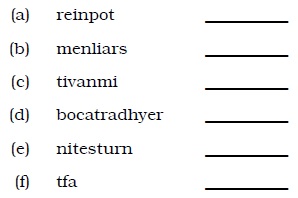
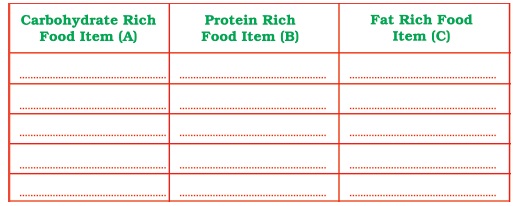

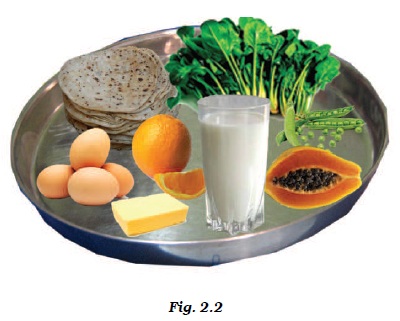
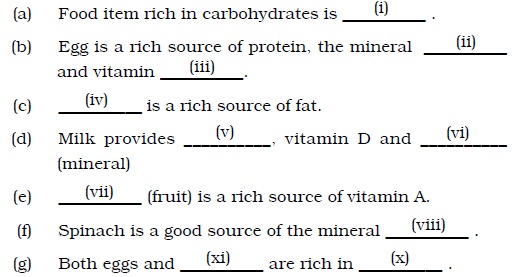
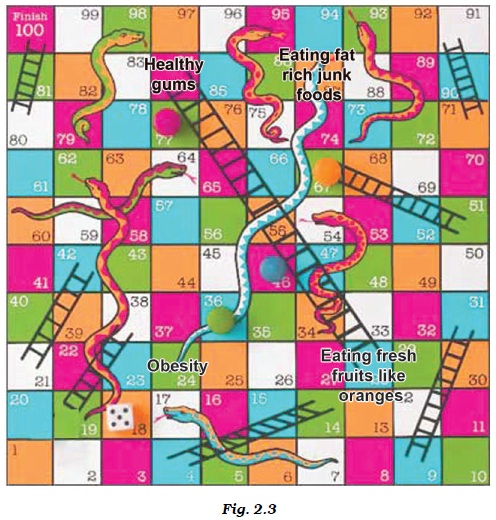
إرسال تعليق